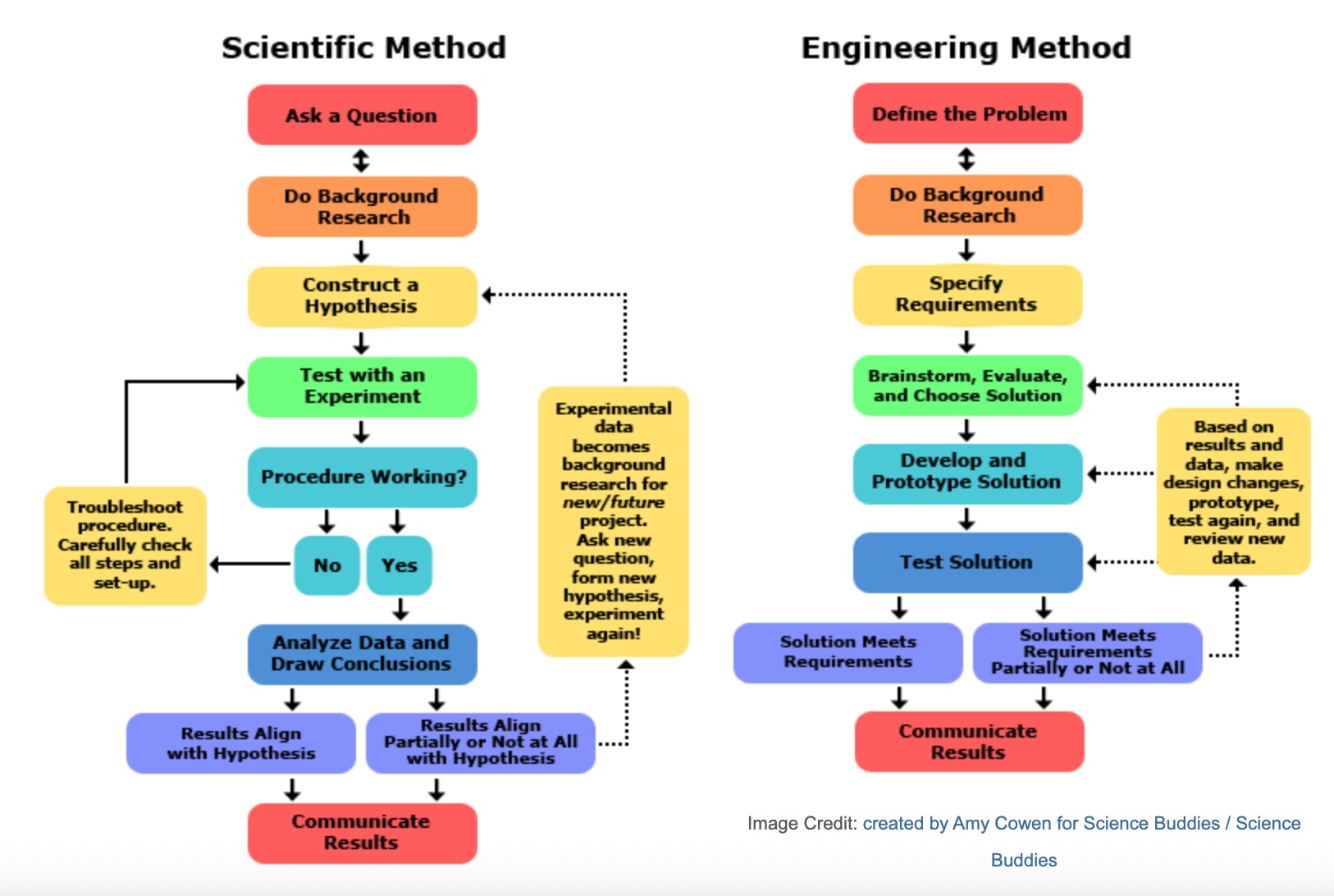-
Aya Fouad posted in the group STEAM Foundation
I have chosen Comparing the Engineering Design Process and the Scientific Method diagram. (Attached).
This resource is a comparative diagram that illustrates the Scientific Method and the Engineering Method , highlighting their similarities and differences. The Scientific Method is depicted on the left, with steps such as “Ask a Question,” “Do Background Research,” “Construct a Hypothesis,” “Test with an Experiment,” and “Analyze Data and Draw Conclusions.” On the right, the Engineering Method includes steps like “Define the Problem,” “Do Background Research,” “Specify Requirements,” “Brainstorm, Evaluate, and Choose Solution,” “Develop and Prototype Solution,” “Test Solution,” and “Communicate Results.” Both methods are visually connected to emphasize iterative processes and the cyclical nature of learning and problem-solving.
Why did you select this resource?
I selected this resource because it provides a clear and concise comparison between the Scientific Method and the Engineering Method. As an educator, I often find that students struggle to differentiate between these two approaches, especially when they are introduced to engineering design for the first time. This diagram helps bridge the gap by showing how both methods share foundational elements (e.g., background research, testing, and communication) while also highlighting their unique focuses (hypothesis-driven experimentation vs. solution-focused prototyping).What made it stand out to you personally or professionally?
Professionally, this resource stands out because it uses a visual format that is easy to understand and engaging. The use of color-coding and arrows to show iterations and feedback loops makes the concepts accessible even to younger learners. Personally, I appreciate how it emphasizes the iterative nature of both methods, which is crucial for teaching students about the importance of revising and refining ideas based on data and results. The inclusion of specific steps like “Troubleshoot procedure” in the Scientific Method and “Develop and Prototype Solution” in the Engineering Method adds depth and realism to the process.How does this resource support the teaching or understanding of the engineering design process?
This resource supports the teaching of the engineering design process by providing a structured framework that mirrors real-world engineering practices. It highlights key stages such as defining problems, brainstorming solutions, prototyping, and testing, which are essential components of engineering. By comparing it to the Scientific Method, students can see how engineering involves more than just experimentation—it requires creativity, collaboration, and practical application.How do you imagine using this in your classroom? How developmentally appropriate is this for your grade level or learners? What modifications would you make to suit your learners or context?
In my classroom, I would use this resource as a starting point for introducing the engineering design process. For middle school or high school students, the diagram is highly appropriate because it aligns with their developing critical thinking and analytical skills. However, for younger students (e.g., elementary grades), I might simplify the language and focus on key steps like “Ask a Question” and “Test a Solution.”To make it more developmentally appropriate for younger learners, I would:
Use simpler vocabulary and add visuals or examples for each step.
Create hands-on activities that mirror the steps in the diagram (e.g., having students define a problem, prototype a solution, and test it).
Incorporate storytelling or scenarios that relate to the students’ interests to make the concepts more relatable.
For older students, I might extend the activity by asking them to analyze real-world engineering projects and map them onto the diagram, or have them compare and contrast the two methods in terms of their applications in different fields.What questions or uncertainties do you still have about this resource?
One question I have is whether the resource could be expanded to include more examples or case studies that illustrate how these methods are applied in real-world contexts. While the diagram is excellent for explaining the steps, additional concrete examples could help students better understand how engineers and scientists actually use these processes. Another uncertainty is whether the resource adequately addresses cultural or interdisciplinary aspects of engineering and science, such as teamwork, ethics, or global perspectives.How might your selected resource foster skills and habits of mind in students (creativity, iteration, communication, research, critical thinking, flexible thinking, problem solving etc.)?
This resource fosters several important skills and habits of mind:Creativity : By encouraging students to brainstorm solutions and prototype designs, it promotes creative thinking and innovation.
Iteration : The emphasis on testing, analyzing results, and revising solutions reinforces the importance of iterative processes in problem-solving.
Communication : Both methods highlight the need to communicate results effectively, which is a critical skill in any field.
Research : The steps involving background research encourage students to gather information and think critically about existing knowledge.
Critical Thinking : Students must evaluate data, assess hypotheses, and determine whether solutions meet requirements, all of which require strong critical thinking skills.
Flexible Thinking : The diagram shows that both methods involve adapting plans based on new information, teaching students to be flexible and open-minded.
Problem Solving : By breaking down complex problems into manageable steps, the resource helps students develop systematic approaches to problem-solving.
User Balance
0
/
Points
Newbie
User Badges
Media
Photos
Videos
Audios
Files
Sorry, no items found.
Friends
Magdoleen Samir Adeeb
@magdoleen-samir-adeeb
Aliyya Dwidar
@aliyya-dwidar
Groups
Instructional Design Course – Group 1
Public Group
Instructional Design Course – Group 2
Public Group
STEAM Foundation
Public Group

